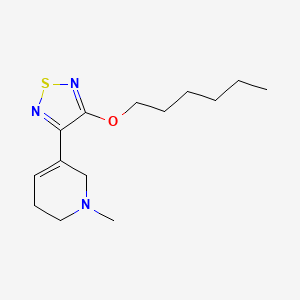



1. (3-o-hexyloxy)-tztp
2. 3-(3-o-hexyl-1,2,5-thiadiazol-4-yl)-1,2,5,6-tetrahydro-1-methylpyridine
3. Ly 246708
4. Ly-246708
5. Ly246708
6. Xanomeline Tartrate
1. 131986-45-3
2. 3-(hexyloxy)-4-(1-methyl-1,2,5,6-tetrahydropyridin-3-yl)-1,2,5-thiadiazole
3. Ly 246708
4. Ly-246708
5. Ly246708
6. 3-hexoxy-4-(1-methyl-3,6-dihydro-2h-pyridin-5-yl)-1,2,5-thiadiazole
7. 9ori6l73cj
8. Chembl21536
9. 5-(4-hexyloxy-[1,2,5]thiadiazol-3-yl)-1-methyl-1,2,3,6-tetrahydro-pyridine
10. Chebi:10056
11. Ly-246708 Free Base
12. 5-[4-(hexyloxy)-1,2,5-thiadiazol-3-yl]-1-methyl-1,2,3,6-tetrahydropyridine
13. Xanomeline (usan)
14. Xanomeline [usan]
15. Pyridine, 3-(4-(hexyloxy)-1,2,5-thiadiazol-3-yl)-1,2,5,6-tetrahydro-1-methyl-
16. Xanomeline [usan:inn]
17. Unii-9ori6l73cj
18. Lumeron
19. Memcor
20. Hexyloxy-tztp
21. Pyridine, 3-[4-(hexyloxy)-1,2,5-thiadiazol-3-yl]-1,2,5,6-tetrahydro-1-methyl-
22. Xanomeline [mi]
23. Xanomeline [inn]
24. Gtpl57
25. 3-(4-(hexyloxy)-1,2,5-thiadiazol-3-yl)-1,2,5,6-tetrahydro-1-methylpyridine
26. Xanomeline [mart.]
27. Xanomeline [who-dd]
28. Schembl121046
29. Dtxsid60157286
30. Bcp31492
31. Ex-a6592
32. Zinc1532358
33. Bdbm50003359
34. Mfcd00867179
35. Akos016007489
36. Db15357
37. Sb18821
38. Nnc-11-0232
39. Ds-15663
40. Hy-105182
41. Cs-0025224
42. Ft-0602214
43. C72296
44. D06330
45. A888347
46. L000694
47. Q8042940
48. Ly-246708; Ly246708; Ly 246708
49. 3-(4-hexoxy-1,2,5-thiadiazol-3-yl)-1-methyl-5,6-dihydro-2h-pyridine
50. 3-(4-hexyloxy-1 ,2,5-thiadiazol-3-yl)-1 ,2,5,6-tetrahydro-1-methyl-pyridine
51. 5-(4-hexyloxy-[1,2,5]thiadiazol-3-yl)-1-methyl-1,2,3,6-tetrahydro-pyridine; Oxalic Acid
52. 5-[4-(hexyloxy)-1,2,5-thiadiazol-3-yl]-1-methyl-1,2,3,6-tetrahydropyridine, Aldrichcpr
53. 1018845-70-9
| Molecular Weight | 281.42 g/mol |
|---|---|
| Molecular Formula | C14H23N3OS |
| XLogP3 | 3.3 |
| Hydrogen Bond Donor Count | 0 |
| Hydrogen Bond Acceptor Count | 5 |
| Rotatable Bond Count | 7 |
| Exact Mass | 281.15618354 g/mol |
| Monoisotopic Mass | 281.15618354 g/mol |
| Topological Polar Surface Area | 66.5 Ų |
| Heavy Atom Count | 19 |
| Formal Charge | 0 |
| Complexity | 298 |
| Isotope Atom Count | 0 |
| Defined Atom Stereocenter Count | 0 |
| Undefined Atom Stereocenter Count | 0 |
| Defined Bond Stereocenter Count | 0 |
| Undefined Bond Stereocenter Count | 0 |
| Covalently Bonded Unit Count | 1 |
Muscarinic Agonists
Drugs that bind to and activate muscarinic cholinergic receptors (RECEPTORS, MUSCARINIC). Muscarinic agonists are most commonly used when it is desirable to increase smooth muscle tone, especially in the GI tract, urinary bladder and the eye. They may also be used to reduce heart rate. (See all compounds classified as Muscarinic Agonists.)
Parasympathomimetics
Drugs that mimic the effects of parasympathetic nervous system activity. Included here are drugs that directly stimulate muscarinic receptors and drugs that potentiate cholinergic activity, usually by slowing the breakdown of acetylcholine (CHOLINESTERASE INHIBITORS). Drugs that stimulate both sympathetic and parasympathetic postganglionic neurons (GANGLIONIC STIMULANTS) are not included here. (See all compounds classified as Parasympathomimetics.)
Psychotropic Drugs
A loosely defined grouping of drugs that have effects on psychological function. Here the psychotropic agents include the antidepressive agents, hallucinogens, and tranquilizing agents (including the antipsychotics and anti-anxiety agents). (See all compounds classified as Psychotropic Drugs.)

LOOKING FOR A SUPPLIER?